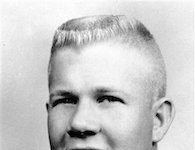On February 4, 1974, members of the Symbionese Liberation Army kidnapped Patty Hearst, 19, granddaughter of newspaper mogul William Randolph Hearst. After months of harsh treatment, Hearst sympathized with the SLA and participated in a series of crimes for which she was later convicted.
SLA Kidnaps Hearst, She Sympathizes With Them
Patricia Hearst was raised in Northern California by Catherine and Randolph Hearst, who had inherited the Hearst media empire from his father William Randolph Hearst. In 1974, 19-year-old Patty was kidnapped from the Berkeley, California, apartment she shared with her fiancé by armed members of the Symbionese Liberation Army, a small group of young left-wing radicals.
Hearst was kept blindfolded in a closet for weeks, and she “would later describe being subjected to hours of revolutionary rhetoric, sleep and food deprivation, rape, and death threats,” according to PBS.
The SLA engaged in public negotiations through the release of audiotapes that featured Hearst’s voice. The organization first demanded the release of two members who were imprisoned for murdering a school superintendent. It then called on Randolph Hearst to distribute millions of dollars of food to the poor; Hearst’s attempts to comply were poorly organized and criticized by Patty in an SLA audiotape.
In early April, Patty Hearst announced that she had joined the SLA and adopted the name “Tania,” after a confederate of Che Guevara. The SLA released a photo of her dressed in guerilla garb and carrying a machine gun.
Sources in this Story
- PBS: Guerilla: The Taking of Patty Hearst
- MSNBC: Kidnapped Heiress: The Patty Hearst Story
- University of Missouri-Kansas City School of Law: Patty Hearst Trial (1976)
- Time: Patty’s Twisted Journey
- The University of Chicago Press: Patty’s Got a Gun: Patricia Hearst in 1970s America
- Slate: What Is the Symbionese Liberation Army?
On April 15, Hearst, toting a machine gun, participated in an SLA robbery of Hibernia Bank. The public became unsure of whether Hearst should now be considered primarily a victim or a perpetrator of a crime. In an SLA audiotape, she declared, “As for being brainwashed, the idea is ridiculous beyond belief. I am a soldier in the People’s Army.”
In May 1974, she fired shots into a Los Angeles storefront to enable colleagues Emily and Bill Harris to escape after a botched robbery. The next day, the LAPD launched a raid on an SLA safe house in Los Angeles that was aired on national television. A fierce gun battle raged before teargas grenades sparked a raging fire; the Hearst family and much of the country watched, wondering if Patty Hearst was inside. While the fire killed six SLA members inside, including group leader “Cinque,” Hearst and several of her companions were not there.
Hearst and the Harrises went on the run, trying to enlist new members and re-arm. Patty was finally arrested in September 1975; while being processed for prison, she listed her occupation as “urban guerilla.”
Related Events
- Italian Red Brigades Kidnapping of Aldo Moro
- Red Brigades Kidnapping of Brigadier General James Dozier
- Quebec Separatist Kidnapping of Pierre Laporte
Patty Hearst on Trial
Hearst was charged with armed robbery for her role in the Hibernia Bank heist. Her attorney, F. Lee Bailey, claimed that she suffered from “Stockholm Syndrome,” in which captives come to sympathize with their captors. Therefore, the defense argued, Hearst’s actions were not voluntary.
“Perhaps the SLA’s treatment of Patty—the violent kidnapping, the sexual abuse, the constant threats, the program of indoctrination—had changed something inside her, made her compliant, willing to do anything,” writes William Graebner, author of “Patty’s Got a Gun.” “Reduced to this state, she resembled others who had been ‘broken’ by their captors and made to do and say things contrary to conscience and character … In this scenario, Patty hadn’t chosen anything, except, perhaps, to stay alive; rather, she was the helpless victim of a powerful new system of mental and physical manipulation.”
In her testimony, Hearst gave unconvincing explanations for her actions and frequently invoked her Fifth Amendment rights. “In the end,” writes University of Missouri-Kansas City School of Law professor Douglas O. Linder, “jurors thought Hearst lied to try to shoehorn her actions into an untenable theory.”
The jury rejected her brainwashing defense, finding her guilty of armed robbery and use of a firearm to commit a felony. She was sentenced to seven years in prison, but President Jimmy Carter commuted her sentence after 21 months. President Clinton granted her a full pardon in 2001.
Background: The SLA
The Symbionese Liberation Army was a small group of “mostly white, upper middle class, well-educated young men and women” who were led by Donald “Cinque” DeFreeze, an escaped black nationalist prisoner, explains PBS. They committed their first criminal act on November 6, 1973, when two members murdered Oakland school superintendent Marcus Foster and injured his assistant, Robert Blackburn.
“They were just a pathetic, mediocre sort of after spasm of the best part of the 60s,” describes Blackburn.
The SLA “adopted its rhetoric from Communists and South American revolutionaries,” according to Slate. A seven-headed cobra was the group’s symbol, and the “Symbionese” name stemmed from “symbiosis,” suggesting “the union of classes and races.”
This article was originally written by findingDulcinea Staff; it was updated December 1, 2016.











